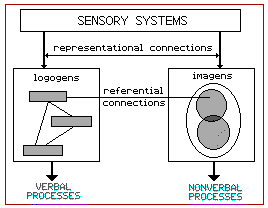of Research in Wearable Computers

| Psychological Basis of Research in Wearable Computers |
 | ||
| Paivio's (1971) Dual Code Hypothesis. One area of psychological research into wearable computers is the multimodal represtation of information in a head -mounted display. The idea is that training materials presented to the audio and visual channels of the brain will be better remembered and learned. This research is based on Paivo's dual coding hypothesis. The dual coding theory proposed by Paivio tries to give equal measure to both verbal and non-verbal processing. Paivio (1986) states: Human cognition is unusal since it has evolved to specialize in dealing simultaneously with language and with nonverbal objects and events. Moreover, the language system is peculiar in that it deals directly with linguistic input and output (in the form of speech or writing) while at the same time serving a symbolic function with respect to nonverbal objects, events, and behaviors. | 
| Much research work in multimedia has been preoccupied with testing Pavio's dual coding theory. For example Mayer and Anderson (1992) Tested the effectiveness of multimedia for learning a scientific process, in this case the process of lighting by placing verbal and pictorial information contiguously in time and space. |
 The theory assumes that two cognitive subsystems exist, the first specialized for the representation and processing of nonverbal objects/events (i.e., imagery), and the second specialized for dealing with language. Paivio also hypthosizes two different types of representational units: "imagens" for mental images and "logogens" for verbal entities which he describes as being similar to "chunks" as described by Miller. Logogens are organized in terms of associations and hierarchies while imagens are organized in terms of part-whole relationships. | Two independent but interacting systems: imagery system: stores images (analogical representation). Associated with right hemisphere processing. stores linguistic information,or verbal descriptions. Associated with left hemisphere processing. Material can be processes in one or both systems:picture: image processing, but you may elect to label the picture (verbal processing).concrete words: verbal processing, but you may elect to form an image. abstract words: verbal processing only. Two codes increase the likelihood of later retrieval. | This multi-modal advantage has been shown to increase learning for declarative tasks similar to the study above. However research by Michas and Berry (2000) using a procedural task, in this case teaching first aid with pictures, videos, text and drawing found that placing text and pictures together in time and space had no significant effect for learning procedural information. |
| |My Research| | |Homepage| | |Wearable Computers| | |Sound| | |Memory Systems| |